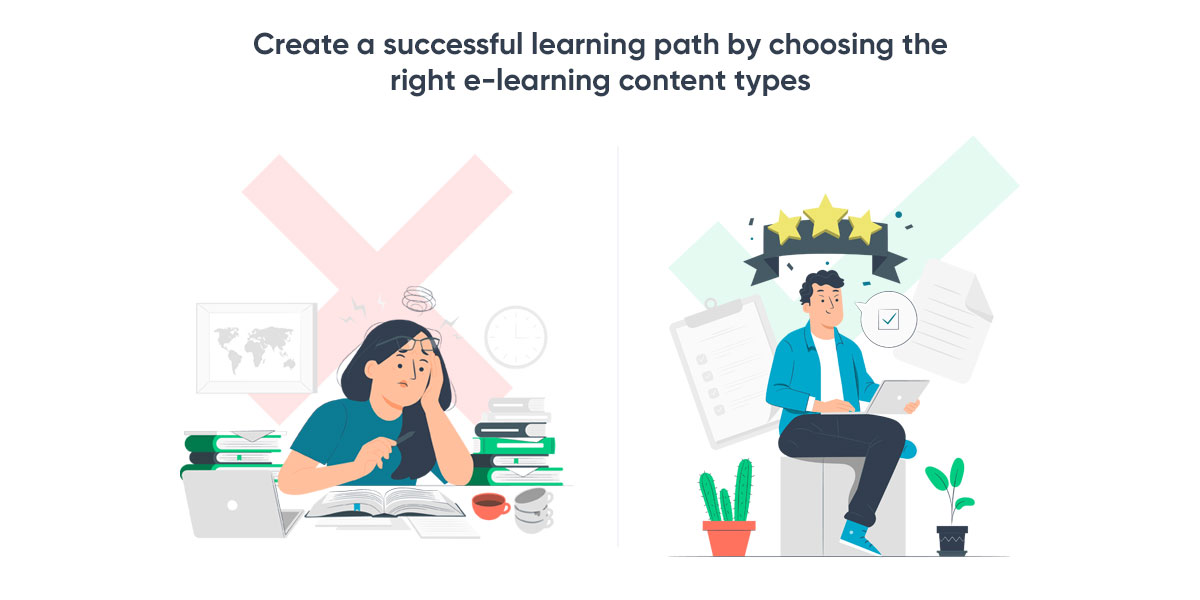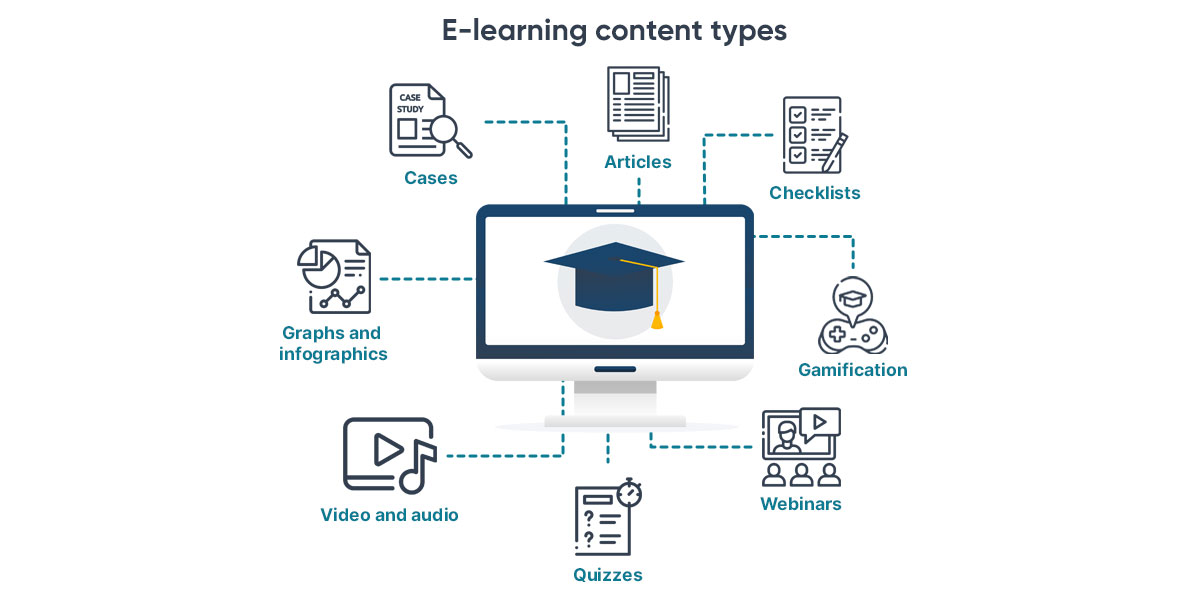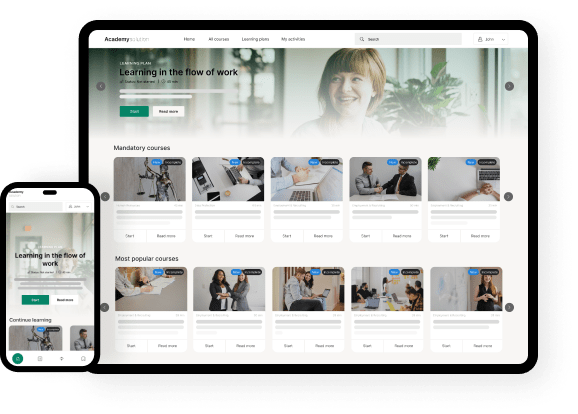Are you in the process of building an online academy, or are you on the lookout for e-learning content inspiration? Deciding between the many e-learning content types for your learning platform may seem like a daunting task if you aren’t an experienced e-learning content creator. How do you make sure your chosen e-learning content will convey the right knowledge? And how do you compose a successful learning path by choosing the right e-learning content types? In this blog post, we’ll answer both these questions.

If you are in the very early stages of setting up your e-learning platform, you can find more information on how to build an online academy here.
How to make e-learning content
E-learning stands for electronic learning.
Typically, e-learning consist of specially curated learning paths, which is sometimes also referred to as learning pathways or learner paths. A learning path takes the learner through a range of learning activities which commonly contain different e-learning content types. Examples could be a video followed by theory-based text snippets followed by a webinar. The learning path might end with an online quiz to test the learner in the material he or she has just gone through.
A clear learning path takes the learner through different e-learning content types that makes sense in the learning process.
Before we dive into the specific e-learning content types that exists, you need to know that you have the option to buy e-learning content from an external content creator. By outsourcing your content creation process, you not only save time and personal resources but you’ll also gain valuable expert insights. This is especially useful if you’re not confident in all e-learning content types. An alternative to buying custom e-learning content is to invest in e-learning courses sold as pre-packaged bundles, which you can implement right away.
If you choose to make your e-learning content yourself, you of course retain the creative control from start to finish.
All types of content production have their advantages and disadvantages. Read more about the three ways to create e-learning content and the pros and cons here. In this blog post, we focus on the latter – namely internal e-learning production also known as in-house content creation.
How to choose the right e-learning category
E-learning content can consist of many different parts and formats. It can be anything from videos or audio files to classic pdf files and interactive games. As long as the purpose is to develop your learners’ knowledge, skills, and performance, you are free to mix and match different e-learning content types. In fact, it is precisely the coupling of one or more content types that make up your e-learning course.
E-learning content can be divided into several different categories, depending on the situation in which the courses are to be used.
As a rule of thumb, there are three main categories within e-learning:
- Performance support → Typically, this content is about tools you need immediately to solve a specific task. For example, it could be a very short step-by-step guide to help the learner perform a task quickly. Or it could be a short video conveying a message in a brief and easy format making it easy for the learner to digest – maybe even when they’re on the go.
- A learning experience → This is about transforming and developing the user’s knowledge over a longer time period. It’s not about immediate learning, but rather about developing competencies for the long run. Oftentimes this content cover slightly heavier topics. With a longer learning experience, you can, for example, use quizzes to match a longer course including theory, cases, statistics, and the like.
- A mix between the above categories → As a cross between the quick performance support and the longer learning experience, you’ll find this last category. This content category often contains supplementary courses to the step-by-step guides and quick and easy e-learning for when you want to know more.
Different e-learning content types and formats
The above categories can be divided into several different e-learning content types. One example could be microlearning. As the name suggests, microlearning divides learning into smaller chunks. This is especially useful in addition to the aforementioned performance support because you with this approach can learn something quickly. With microlearning you can use your newly required knowledge immediately after reviewing the content. You can read more about microlearning in our blog post here.
More examples of e-learning content types:
- Video and audio → Video is an excellent e-learning format, but make sure your videos aren’t too long. Aim for less than 10 minutes and supplement with text.
- Graphs or infographics → These are excellent as a supplement to heavier texts.
- Cases → They link what is taught to concrete examples so the learner better understands and remembers.
- Articles → Classic articles and white papers can be used for heavier topics or theory that requires a deeper explanation.
- Checklists → These are effective at the end of a course for the learner to summarize what they’ve just learned.
- Gamification → All kinds of games or interactive elements are able to take your e-learning to the next level and engage your learners. Try giving points or use prizes as incentives for completing tasks. Game elements are used as an additive element to retain the learner and make your knowledge more entertaining and captivating.
- Webinars → These can be used for classical teaching, lectures, and interactive learning.
- Quizzes → Like a checklist, they can be an effective way to summarize the learning. They’ll both help the learner remember the content and test them in what they have just learned.

Choose the right e-learning content types for your target audience
In your e-learning production, you can mix and match the three categories and many subtypes to best capture your target audience. So, spend time to first find out what situation your target group is in. And then look into which category, your topics and courses best fit into.
If it’s a complicated topic and your learners aren’t under time pressure, choose a well-thought-out learning experience and include several different e-learning content types. You can, for example, mix articles, white papers, videos, and checklists. If your target group instead needs to complete a task immediately, you could opt for performance support and go with a video guide.
Start your e-learning production now
We hope reviewing the different categories and e-learning content types suitable for your learning platform has inspired you. Remember, the focal point of your online academy is content. Therefore, it’s very important that you dedicate time to consider the different e-learning content types. This way your audience gets the most and best out of their learning experience.
No matter what e-learning content types you choose, we at Cursum can provide you with an effective learning platform to distribute your e-learning content. Contact us to get a demo of our platform.


